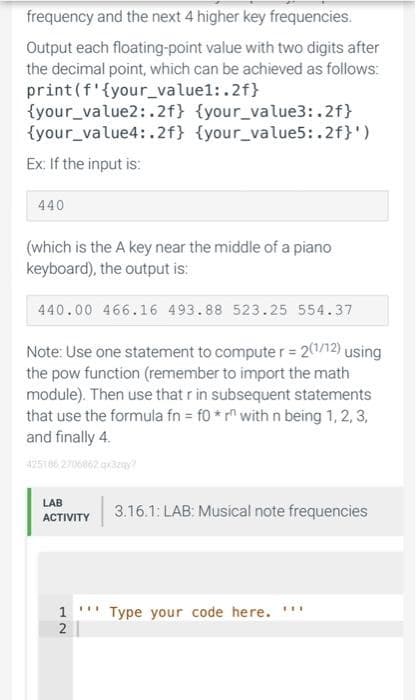frequency and the next 4 higher key frequencies. Output each floating-point value with two digits after the decimal point, which can be achieved as follows: print (f' {your_value1:.2f} {your_value2:.2f} {your_value3:.2f} {your_value4:.2f} {your_value5:.2f}') Ex: If the input is: 440 (which is the A key near the middle of a piano keyboard), the output is: 440.00 466.16 493.88 523.25 554.37 Note: Use one statement to computer = 2(1/12) using the pow function (remember to import the math module). Then use that r in subsequent statements that use the formula fn = f0*r" with n being 1, 2, 3, and finally 4. 4251862706862.qx3zay? LAB ACTIVITY 3.16.1: LAB: Musical note frequencies 1 Type your code here. *** 2
frequency and the next 4 higher key frequencies. Output each floating-point value with two digits after the decimal point, which can be achieved as follows: print (f' {your_value1:.2f} {your_value2:.2f} {your_value3:.2f} {your_value4:.2f} {your_value5:.2f}') Ex: If the input is: 440 (which is the A key near the middle of a piano keyboard), the output is: 440.00 466.16 493.88 523.25 554.37 Note: Use one statement to computer = 2(1/12) using the pow function (remember to import the math module). Then use that r in subsequent statements that use the formula fn = f0*r" with n being 1, 2, 3, and finally 4. 4251862706862.qx3zay? LAB ACTIVITY 3.16.1: LAB: Musical note frequencies 1 Type your code here. *** 2
Computer Networking: A Top-Down Approach (7th Edition)
7th Edition
ISBN:9780133594140
Author:James Kurose, Keith Ross
Publisher:James Kurose, Keith Ross
Chapter1: Computer Networks And The Internet
Section: Chapter Questions
Problem R1RQ: What is the difference between a host and an end system? List several different types of end...
Related questions
Question

Transcribed Image Text:frequency and the next 4 higher key frequencies.
Output each floating-point value with two digits after
the decimal point, which can be achieved as follows:
print (f'{your_valuel:.2f}
{your_value2:.2f} {your_value3:.2f}
{your_value4:.2f} {your_value5:.2f}')
Ex: If the input is:
440
(which is the A key near the middle of a piano
keyboard), the output is:
440.00 466.16 493.88 523.25 554.37
Note: Use one statement to computer = 2(1/12) using
the pow function (remember to import the math
module). Then use that r in subsequent statements
that use the formula fn = f0 *r with n being 1, 2, 3,
and finally 4.
425186 2706862.qx3zqy?
LAB
ACTIVITY
3.16.1: LAB: Musical note frequencies
1 Type your code here. **
2
Expert Solution
This question has been solved!
Explore an expertly crafted, step-by-step solution for a thorough understanding of key concepts.
Step by step
Solved in 3 steps with 1 images

Recommended textbooks for you

Computer Networking: A Top-Down Approach (7th Edi…
Computer Engineering
ISBN:
9780133594140
Author:
James Kurose, Keith Ross
Publisher:
PEARSON

Computer Organization and Design MIPS Edition, Fi…
Computer Engineering
ISBN:
9780124077263
Author:
David A. Patterson, John L. Hennessy
Publisher:
Elsevier Science

Network+ Guide to Networks (MindTap Course List)
Computer Engineering
ISBN:
9781337569330
Author:
Jill West, Tamara Dean, Jean Andrews
Publisher:
Cengage Learning

Computer Networking: A Top-Down Approach (7th Edi…
Computer Engineering
ISBN:
9780133594140
Author:
James Kurose, Keith Ross
Publisher:
PEARSON

Computer Organization and Design MIPS Edition, Fi…
Computer Engineering
ISBN:
9780124077263
Author:
David A. Patterson, John L. Hennessy
Publisher:
Elsevier Science

Network+ Guide to Networks (MindTap Course List)
Computer Engineering
ISBN:
9781337569330
Author:
Jill West, Tamara Dean, Jean Andrews
Publisher:
Cengage Learning

Concepts of Database Management
Computer Engineering
ISBN:
9781337093422
Author:
Joy L. Starks, Philip J. Pratt, Mary Z. Last
Publisher:
Cengage Learning

Prelude to Programming
Computer Engineering
ISBN:
9780133750423
Author:
VENIT, Stewart
Publisher:
Pearson Education

Sc Business Data Communications and Networking, T…
Computer Engineering
ISBN:
9781119368830
Author:
FITZGERALD
Publisher:
WILEY